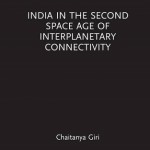During the initial decades (the 1960s and 1970s) of the First Space Age, space exploration was on the science and national pride agenda only of the U.S. and Soviet Union. The Cold War between them made it possible for large budgetary allocations to space exploration projects, particularly human spaceflight. In those decades, these were the only two nations to possess launch capacities that lifted space-craft’s heavier than two tonnes warranted by such missions. Japan and France began developing mid- (1–1.5) and heavy-lift (1.5 and above) launch vehicles in the 1980s, which immediately helped them initiate their planetary exploration missions. India and China began space exploration in the early 2000s. China initiated human spaceflight in 2003 with its heavy-lift launch vehicle Long March 2F. The same rocket will soon assemble its large modular space station, for executing its Chinese Lunar Exploration Program (CLEP) and its future mission to Mars. India began its Chandrayaan lunar exploration programme with a mid-lift 1.5 tonne Polar Synchronous Launch Vehicle (PSLV). It is now graduating to human spaceflight and heavy-payload planetary missions with its 2.5 tonne plus heavy-lift Geosynchronous Satellite Launch Vehicle Mark III (GSLV Mk-III) and the underdeveloped Unified Launch Vehicle (ULV).
Now on the Second Space Age cusp, countries like New Zealand, Germany, the United Kingdom, which never had a rocketry portfolio in their respective space programme, have begun to harness space launch capabilities. They focus on smaller and low-lift launch vehicles to cater to the growing demand for launching miniaturised satellites and spacecraft. Nations from the economically developed world like Luxembourg, Switzerland, Austria, Australia and Canada have begun to identify space applications, with Fourth Industrial Age (Industry 4.0) characteristics, to the best of their technological competencies. Luxembourg intends to explore space applications from its existing proficiencies in financial technology, banking and investments. Australia offers commercial spinoffs of its rich heritage of space-based military surveillance and ground-based communications infrastructure. Economically developing nations like Bangladesh, Nigeria and Malaysia have limited space competence but are making pragmatic space collaborations with nations having advanced technology competencies.
As more nations begin pursuing space activities, exploration will transform from a government-driven activity into a commercial applied-science-driven enterprise. Many nations, and the technology innovation and manufacturing ecosystems within them, will pursue space exploration clustering around a few techno-economic super-powers with whom they align politically, economically and militarily. This book deems these clusters as astropolitical blocs. Typically, astropolitical blocs would affiliate on political, economic and military aspects and share financial, industrial, natural, human and academic Introduction resources. The bloc members will seldom share these resources outside the blocs. Such clustering will be a vital facet of a geopolitically multi-polar world. With more claimants to the tag of a superpower, such nations will keep a band of countries, those at lower pedestals of power than them, who could barter vital resources with them.
The Second Space Age will see many nations investing in the global space economy. They are contemplating frequent expeditionary missions to the Moon, near-Earth asteroids and Mars, some of the nearest Solar System bodies to the Earth. Astropolitical bloc leaders aim to install an interplanetary connectivity network with exclusive access only for the bloc members. These superpower countries intend to marry each of their space industrial ecosystems (consisting of academia, technology start-ups, medium-scale technology providers, large-capital technology conglomerates in collaboration with the space agencies) to construct and operate these interplanetary connectivity networks. With these entities joining in, the contest between the astropolitical blocs will be much broader in scope and consequence than the Cold War-era Space Race, which extinguished with the U.S. reaching the Moon first. The new contest will be drawn out perhaps on the scale of centuries. It will be like the board game of igo or better known as Go, where more than two blocs will intend to secure more interplanetary and extraterrestrial expanse in their control than the other. The extant astropolitical blocs have begun to exercise their coordinated long-term plans. They are planning to set up long-term habitats – space stations, Earth’s and Moon’s orbits, surface crewed and robotic outposts on the Moon and Mars, and the capability of faster-crewed transportation systems on Mars. Long-term robotic and human presence on Moon and Mars will demand continuous logistics supplies, consistent, low-latency and uninterrupted communications, low-cost and frequent transportation systems, investments in advanced materials, new energy storage technologies, long-duration life-support systems, cyber-physical systems, robots, internet-of-things, among others. Many of these technologies will stem from the civilian-commercial Industry 4.0 innovation ecosystems within the astropolitical blocs. These plans are to be initiated immediately, beginning the decade of 2020s.The techno-economic output emerging from the interplanetary connectivity networks of various astropolitical blocs will make unique flourishes to the global space economy and the larger world economy. This economic growth is a comprehensive lever on which astropolitical blocs will begin to amend to the notion of outer space as global commons, codified under the 1967 Outer Space Treaty.
Giri, Chaitanya, India in the Second Space Age of Interplanetary Connectivity. Routledge India, 2022.
Chaitanya Giri is former Fellow, Space and Ocean Studies, Gateway House.
This excerpt was exclusively written for Gateway House: Indian Council on Global Relations. You can read more exclusive content here.
This book is part of The Gateway House Guide to India in the 2020s. You can purchase the book here.
For interview requests with the author, or for permission to republish, please contact outreach@gatewayhouse.in.
© Copyright 2022 Gateway House: Indian Council on Global Relations. All rights reserved. Any unauthorized copying or reproduction is strictly prohibited.


